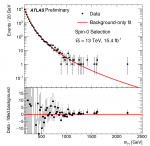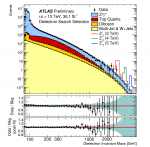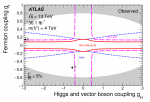Di-photon resonance searches
Since 2013 our group is the leading driving force behind the ATLAS search for high-mass diphoton resonances. This analysis is a spin-off of the commitment to the measurement of the Higgs boson properties in its diphoton decay. This analysis was first performed using 8 TeV data, with a complete and exclusive implication of the LAPP group that developed all steps of the search, result and publication. In the first 13 TeV data an intriguing excess at a mass of about 750 GeV was observed, which caused a lot of excitement in theoretical community as well as public. Unfortunately in the 2016 data the 750 GeV excess was not confirmed. The group currently maintains an open activity in this area, especially planning the extension of the search in the mass region below 125 GeV, where the presence of additional resonances has a strong theoretical motivation in the context of models with extended Higgs sectors (NMSSM, 2HDM).
Contacts: Nicolas Berger, Rémi Lafaye
Relevant publications:
Dielectron resonance searches
Since the beginning of the data-taking in 2009 our group has participated in the searches for new resonances in the dielectron final state. No excess over the standard model predictions is found in the current dataset but increasingly stringent limits were set, raising from 1 TeV in 2009 to 5.1 TeV for the SSM Z’ (a heavier cousin of the SM Z bozon) in the latest Run-2 results.
Contact: Tetiana Hryn’ova
Relevant publications:
- Search for high-mass dilepton resonances using 139 fb^−1 of pp collision data collected at √s=13 TeV with the ATLAS detector,
- Search for new high-mass phenomena in the dilepton final state using 36 fb^−1 of proton-proton collision data at √s = 13 TeV with the ATLAS detector
Combination of the heavy resonance searches
New phenomena could occur in more than one final state. Individual analyses only constrain a subset of the model parameters or have a limited sensitivity to them, but combination of channels leads to much stronger simultaneous constraints, exploiting their complementarity as shown in Figure.
Contact: Tetiana Hryn’ova
Relevant publications:
- Combination of searches for heavy resonances decaying into bosonic and leptonic final states using 36 fb^−1 of proton-proton collision data at √s=13 TeV with the ATLAS detector; Phys. Rev. D 98 (2018) 052008
- Combination of searches for heavy resonances using 139 fb^−1 of proton-proton collision data at √s=13 TeV with the ATLAS detector



















